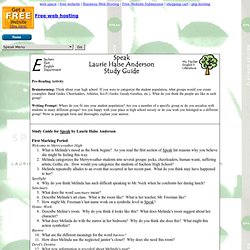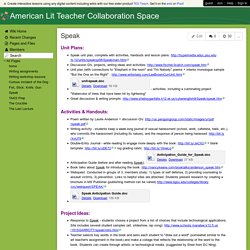

Pov_hidingandseeking_rep4. Speak. Unit Plans | Objectives | Literary Terms | Activities | Motifs | Vocabulary | Literary Analysis | Discussion Questions | Journal Topics | Interdisciplinary Connections | Mr. Freeman's Wisdom | Help: if YOU need to Speak! | Unit Objectives: Read and discuss the novel (follow reading schedule) Practice reading strategies: anticipatory and during reading strategies Define and learn unfamiliar vocabulary Introduce basic elements of literature; work towards mastery of literary terms Introduce literary analysis and expository essay Use Word for peer review Discuss the idea of free speech, study the Pledge of Allegiance Review traits of writing (voice, word choice, organization & conventions) Create a fictionalized journal entry from one character's point of view (voice and point of view) Engage in an online discussion about the novel Literary Terms: Activities: Motifs: mirrors mouths trees Vocabulary: Choose 15 words from this list.
Defined Terms: Discussion Questions: Interdisciplinary Connections: Speak Out! Reach Out! Download as a PDF A Thematic Unit Using Laurie Halse Anderson’s Novel Speak and the Arizona English Language Arts Standards by Dr.

Lee Brown, Assistant Professor of Secondary Education Arizona State University West College of Teacher Education and Leadership and Amanda Logan This teacher’s guide is Copyright 2004 by the authors. It is reproduced here with their kind permission. First published in Arizona English Bulletin, journal of the Arizona English Teacher Association (AETA). At next year’s AETA conference, participants will have the opportunity to meet and work with one of today’s most celebrated Young Adult Literature authors–Laurie Halse Anderson. In short, Laurie Halse Anderson is a phenomenal writer. It is AETA’s hope that many of you will have the opportunity to work with Speak prior to the conference. Curriculum Development Outline The unit was developed using the four kinds of objectives described below. I.
II. III. IV. Name__________________________ The student will: Study Guide for Speak by Laurie Halse Anderson. Authors use figurative language to create a picture in the readers’ minds.

Most of the time, the author is comparing what is really happening with something people are familiar with, allowing the reader to make a connection with what is happening in the novel. Figurative language also allows the author to express in more a powerful way what is occurring in the novel. Some literary elements that are used to create figurative language are: Simile: a comparison between two unlike things using the words like or as. Metaphor: a comparison between two unlike things without using the words like or as.
Personification: giving human qualities to non-living objects. Activity One: Read the examples of figurative language from Speak listed below. 1. ____ Words climb up my throat. 2. ____ I dive into the stream of fourth-period lunch students and swim down the hall to the cafeteria. 3. ____ I have been dropped like a hot Pop Tart on a cold kitchen floor. 5. Check your answers: Speak by Laurie Halse Anderson Daily Lesson Plans. American Lit Teacher Collaboration Space - Speak. Skip to main content Create interactive lessons using any digital content including wikis with our free sister product TES Teach.

Get it on the web or iPad! Guest Join | Help | Sign In American Lit Teacher Collaboration Space Home guest| Join | Help | Sign In Turn off "Getting Started" Loading...